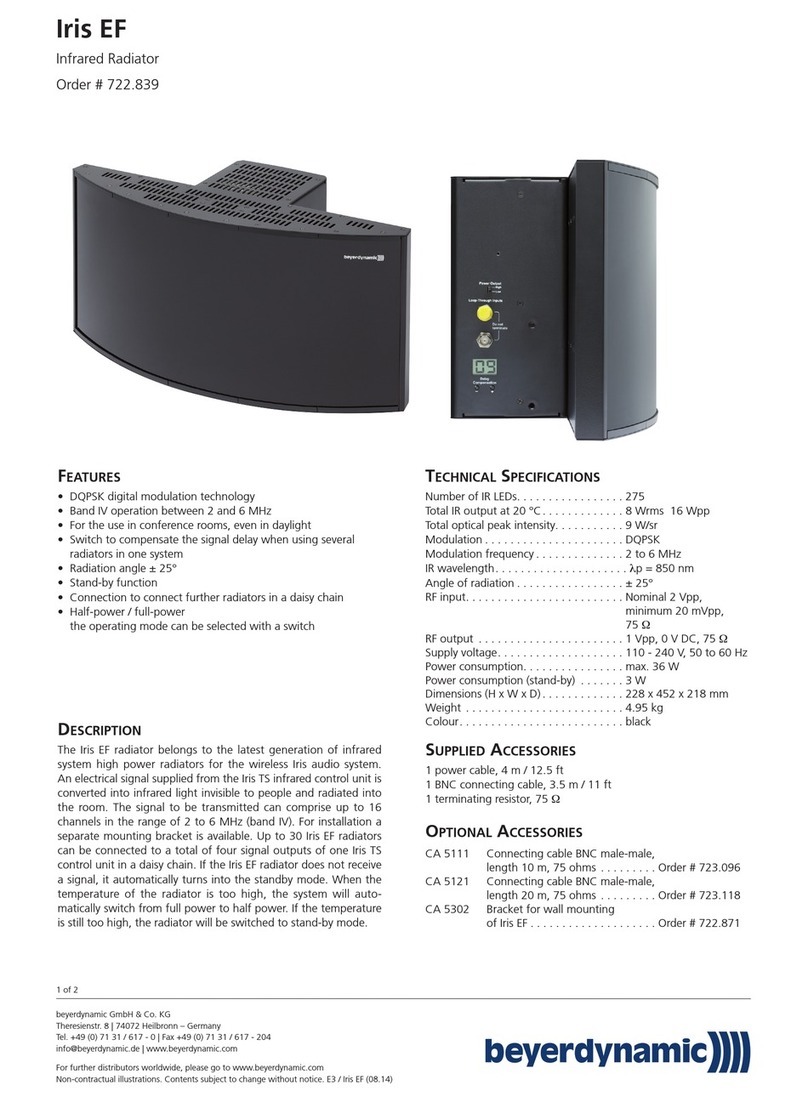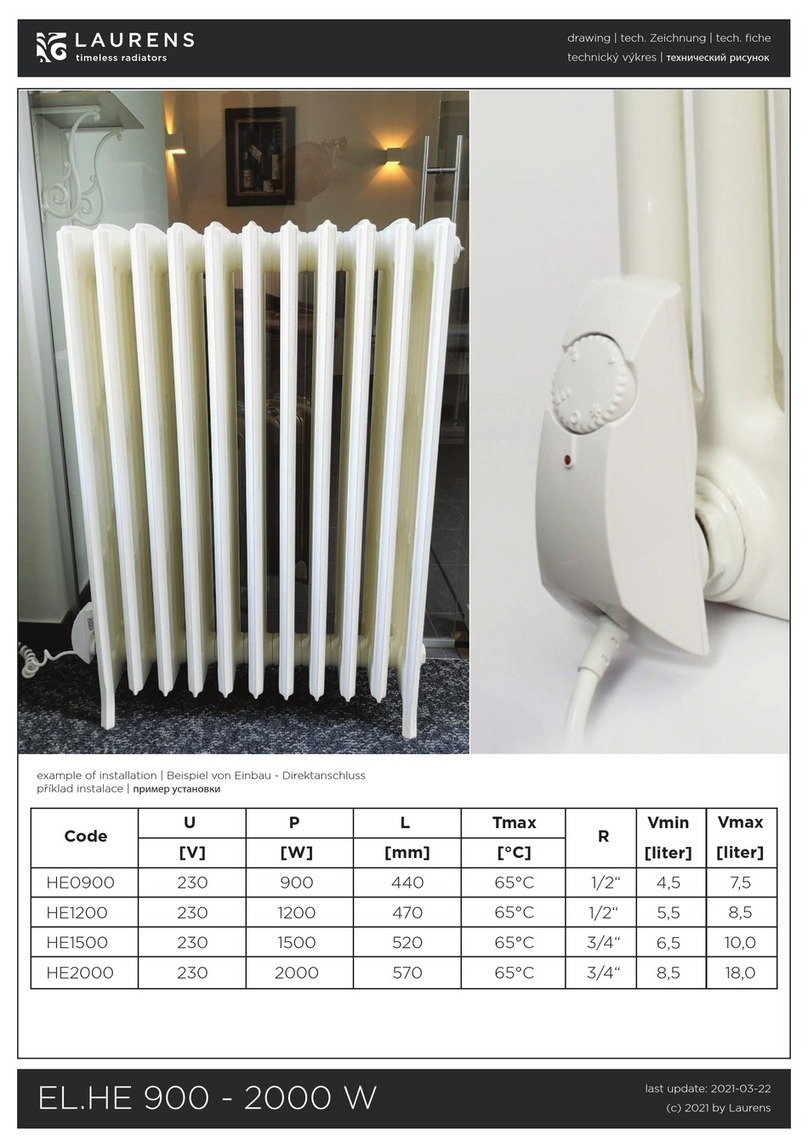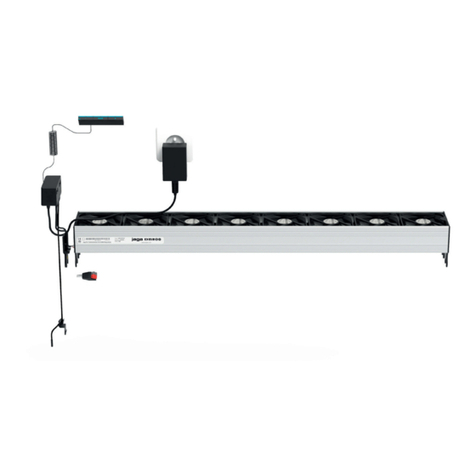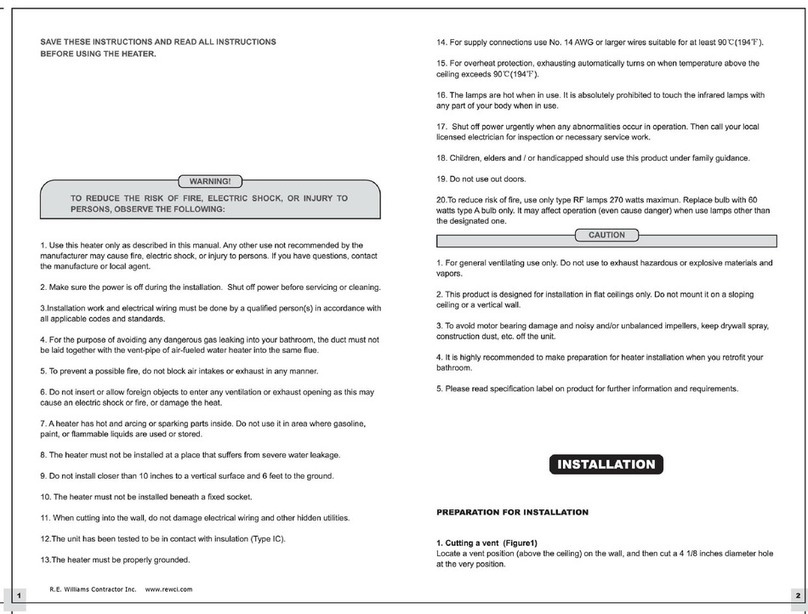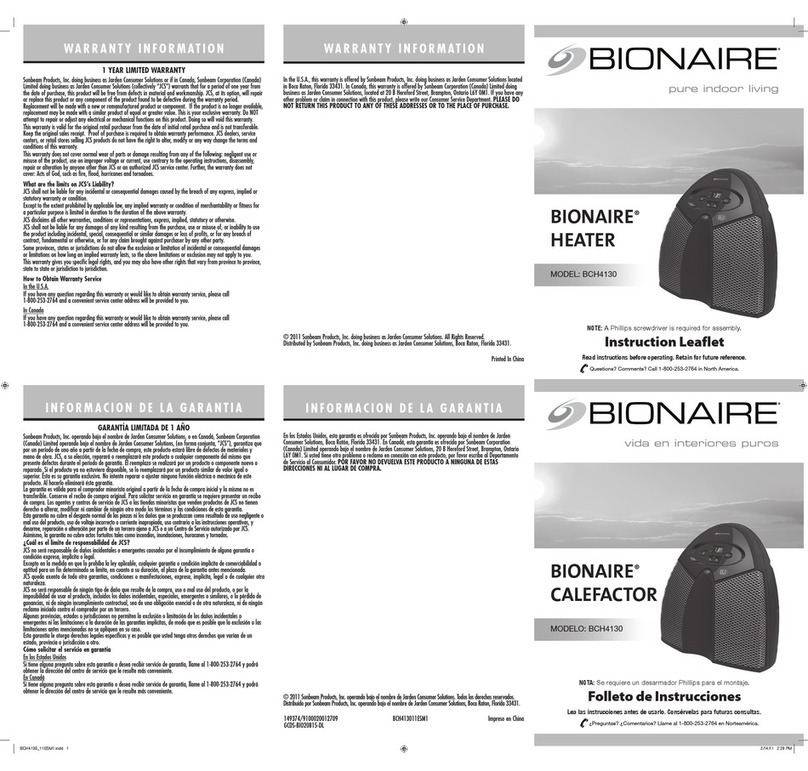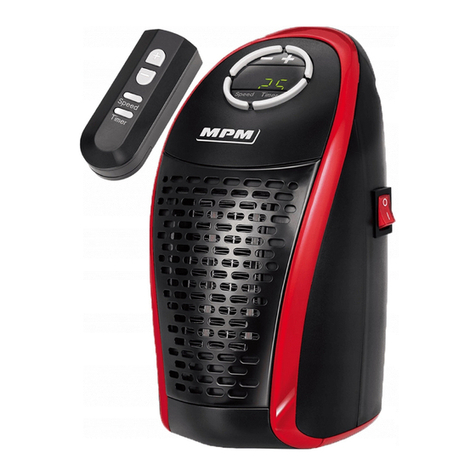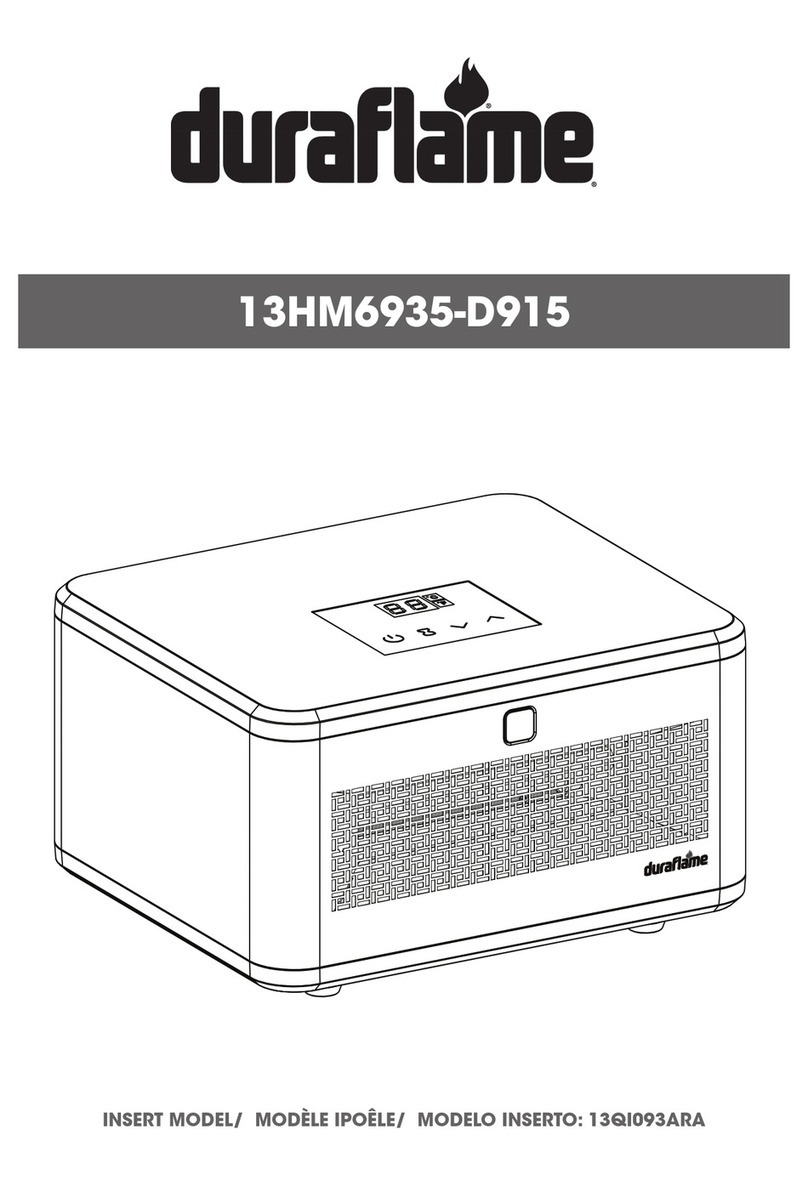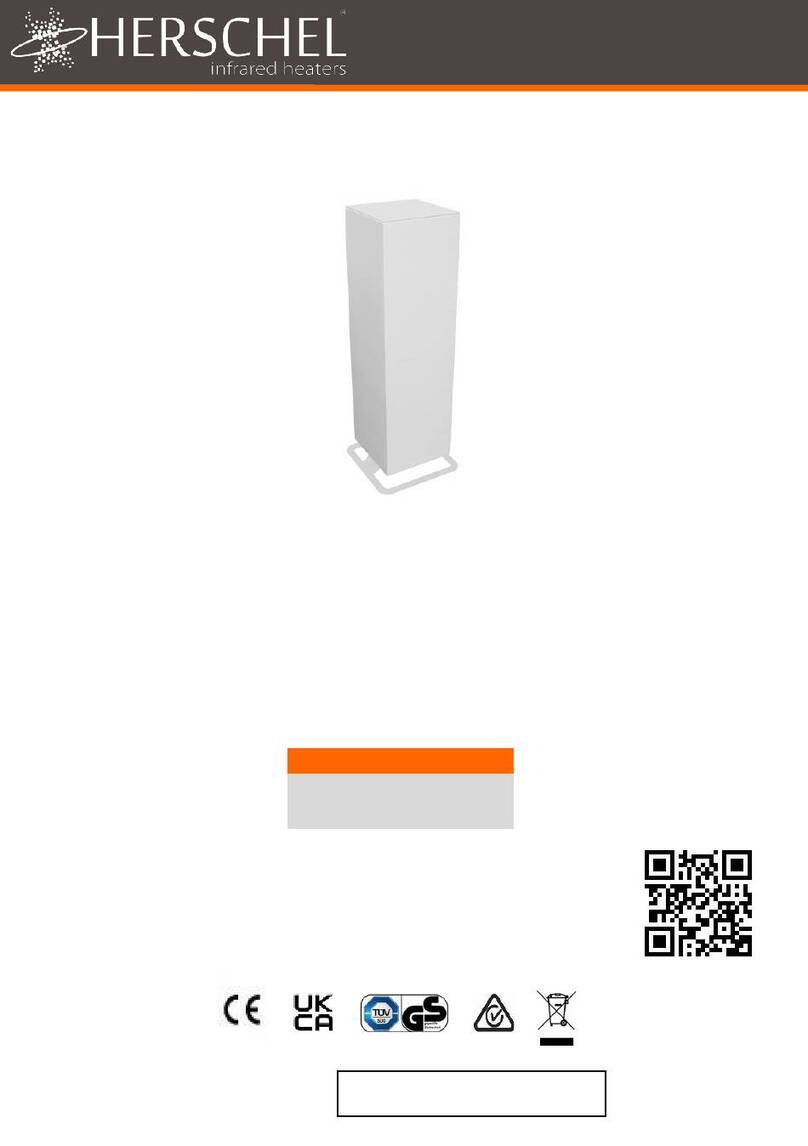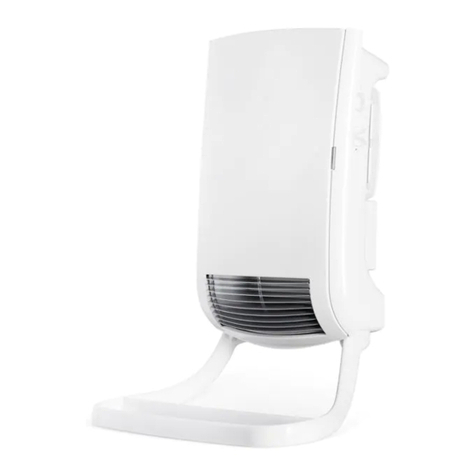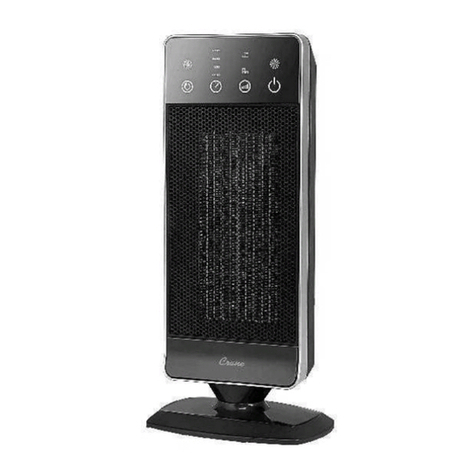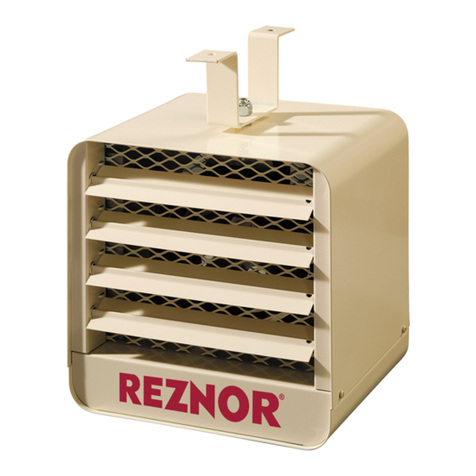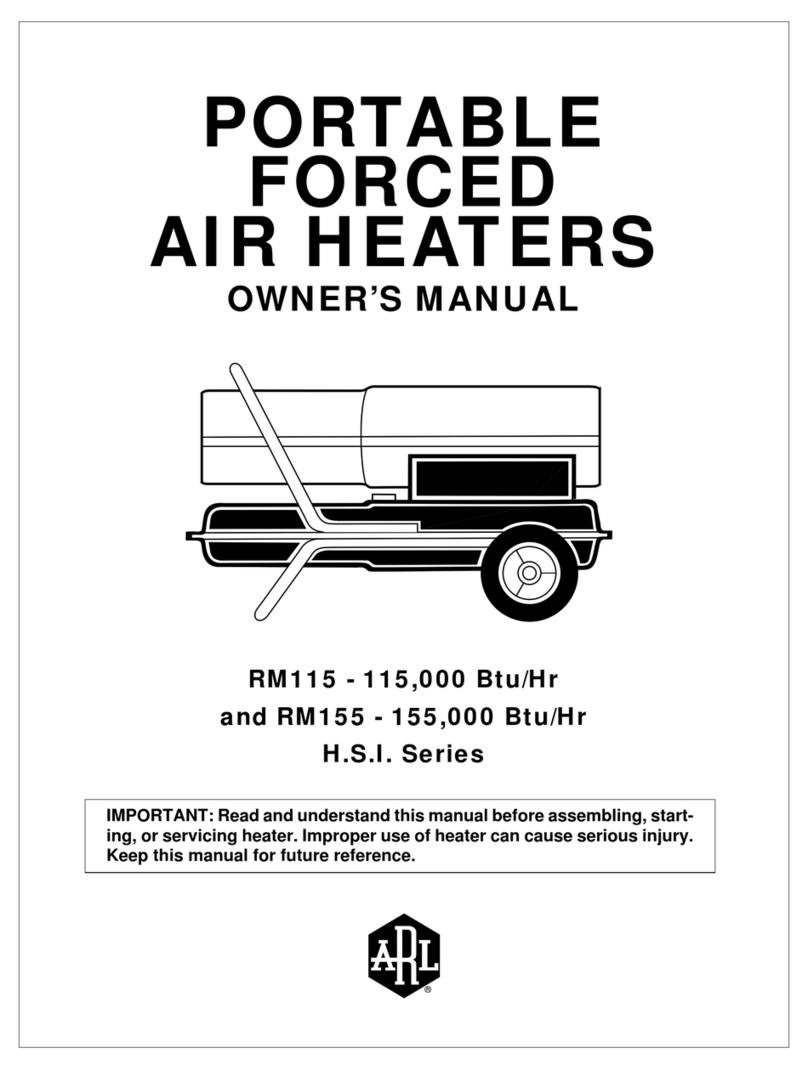Beyerdynamic SIR 802 User manual

Operating Instructions
Ver. 1.0
SIR 802
High Power Radiator

SIR 802
2Copyright by beyerdynamic GmbH & Co. KG
SIR is a trademark of beyerdynamic GmbH & Co. KG.
Printed in Germany
If you have any questions about this manual please contact:
beyerdynamic GmbH & Co. KG
Theresienstr. 8
D-74072 Heilbronn
Tel. +49 (0)7131 617-0
Fax +49 (0)7131 617-224
E-Mail info@beyerdynamic.de
You will find further information about our products on the internet at:
www.beyerdynamic.com
© 2009
beyerdynamic GmbH &. Co. KG
All rights reserved, especially (also partly) the translation, reprint, reproduction through copying or other
similar methods.
beyerdynamic reserves the right to make changes without notice.
Nov 2009

SIR 802
Copyright by beyerdynamic GmbH & Co. KG 3
Content
About this manual ........................................................................................................... 4
Symbols ..................................................................................................................................................................................................... 4
Important indications ...................................................................................................... 6
General information ................................................................................................................................................................................... 6
Safety information...................................................................................................................................................................................... 6
1. Description................................................................................................................... 7
1.1 System Function.................................................................................................................................................................................. 7
1.2 Uses ..................................................................................................................................................................................................... 7
1.3 Components ........................................................................................................................................................................................ 8
2. SIR 802 High Power Radiator IRad............................................................................. 8
Description ................................................................................................................................................................................................. 8
3. Installation.................................................................................................................. 11
3.1 Installation of the Infrared System .................................................................................................................................................... 11
3.1.1 Planning the Infrared field ......................................................................................................................................................... 11
3.1.1.1 Number of channels to be transmitted ............................................................................................................................. 12
3.1.1.2 Size of infrared field to be planned................................................................................................................................... 12
3.1.1.3 Seating arrangement......................................................................................................................................................... 14
3.1.1.4 Possible positions for radiators and their height .............................................................................................................. 15
3.1.1.5 Lighting conditions ............................................................................................................................................................ 15
3.1.1.6 Surfaces of walls, ceilings and floors, curtains ................................................................................................................ 16
3.1.1.7 Sources of electrical interference ..................................................................................................................................... 16
3.1.2 Installation of the radiators........................................................................................................................................................ 16
3.1.2.1 Assembly with CA 5301 (Order # 484.776)...................................................................................................................... 17
3.1.2.2 Tripod assembly with the ST 600 (Order # 421.316)....................................................................................................... 18
3.1.3 Connecting the radiators to the control console (band II operation) ....................................................................................... 19
3.1.4 Distribution Amplifier, cable lengths, terminal resistance ........................................................................................................ 19
Scope of delivery........................................................................................................... 21
Accessories.............................................................................................................................................................................................. 21
Appendix ........................................................................................................................22
Technical Data ......................................................................................................................................................................................... 22
Trouble shooting ...................................................................................................................................................................................... 23

SIR 802
4Copyright by beyerdynamic GmbH & Co. KG
About this manual
Symbols
The following symbols and fonts are used in this manual:
Indicates an important note, which has to be followed to guarantee that the functions of the unit, the
security of any data or your health are not put at risk
Indicates additional information, remarks and tips
Describes activities that must be performed in the shown order
Words in bold letters require your special attention

SIR 802
Copyright by beyerdynamic GmbH & Co. KG 5
CAUTION
DANGER OF ELECTRIC SHOCK
DO NOT OPEN DEVICES
Do not open housing with mains cable connected.
Maintenance operations may only be executed by
qualified personnel.
Our equipment and installations have been built and tested according to the latest state of the art. Under
normal conditions, they do not require any special maintenance.
However, please be aware of the following:
Positioning - secure and stable position of the equipment
Ventilation - operate equipment with proper ventilation. Avoid heat sources such as heating radiators
etc.
Mains connection – pass all power cables so that they will not be damaged
Cable connections - avoid trip-traps
Liquids - avoid penetration of liquids into the housing
Power sockets - operate equipment only with power sockets that are connected to ground according to
the relevant specifications and regulations
Warning: Never expose equipment to rain or humidity
Rough handling of the equipment, such as strong shocks or vibrations, may result in damages. Inappropriate
handling and storage, which does not conform to the operating instructions, may also lead to equipment
damages

SIR 802
6Copyright by beyerdynamic GmbH & Co. KG
Important indications
General information
Please read this manual carefully before starting operation. Keep this manual together with the SIR 802
radiator. If you pass on the units to other parties, please include this manual.
Because the radiator only operates in connection with appropriate receiver (SIR 320), here some important
notes:
Don’t use non rechargeable and rechargeable batteries together in one receiver!
You will invalidate the warranty and damage the receiver.
In no case it is allowed to charge receivers with non rechargeable batteries!
Attention! – Polarity
During insertion of new non rechargeable/rechargeable batteries take care of the correct polarity.
Wrongly inserted batteries will cause malfunctions. Wrongly inserted batteries can leak and destroy
the equipment.
Changing of batteries
When changing the batteries the receiver may stop reacting. In this case please carry out a hardware
reset. (See paragraph Operation > Hardware reset)
The warranty invalidates, if you cause (generate, precipitate) inappropriate use or handling of the
unit.
Safety information
The receiver should not be used at the maximum volume setting (value 15), because high volume
levels might damage your hearing!
If other headphones than beyerdynamic models are used then a sound pressure of 96dB SPL at
maximum volume may be not exceeded.
Please contact our service / sales team if you have any questions

SIR 802
Copyright by beyerdynamic GmbH & Co. KG 7
1. Description
1.1 System Function
SIR is a system for the wireless transmission of sound using infrared light. One of the most important
applications is the simultaneous-interpretation mode in combination with interpreter consoles (e.g. SIS).
The SIR system consists of several components:
The main component is the control console. The input sources are signals from several audio components
(for instance, several different language channels with simultaneous interpretation). It converts them into the
appropriate FM signals for wireless transmission.
Infrared radiators transmit the information carried by the audio channels in the form of frequency-modulated
infrared light.
Within the radiator's range, receivers are used to pick up the information transmitted in the form of infrared-
light signals. These receivers are about the size of a pack of cigarettes. Headphones are plugged in to listen
to the audio output. Receivers can be moved anywhere within the area that is fully illuminated by the
radiators. They can be switched to receive up to 32 channels.
Whenever the SIR system is used as a simultaneous-interpretation installation it operates in combination
with one or several interpreter consoles, feeding in the various languages into the appropriate outgoing
channels. The interpreter consoles also incorporate a number of functions that are essential to ensure the
continuously transmission of simultaneous translation.
The interpreter consoles are installed inside sound-proofed interpreter booths.
Interpreters inside these booths using headphones to listen to the original sound, which is normally called
the floor channel. At the same time, they speak their translation - simultaneously in another language.
Where ever we have a combination of an SIR system and SIS interpreter consoles it is SIR to transmit
several wireless audio channels simultaneously to a conference room.
The purpose of the interpreter console is to feed in the various languages to the appropriate outgoing
channels.
1.2 Uses
In combination with a microphone management system (such as MCS-D 200, MCW-D 200), the system
can provide the best possible communication for organised events that need to use several languages:
Each and every participant (a term often used is "delegate") can use the microphone system to speak, and
what he or she says will be translated simultaneously so that other delegates will be able to listen to it in one
of several languages. This technique permits direct communication in several languages even at very
large-scale events.
It is simple to use SIR system in such a way that it is protected to the outside. Since all information is
transmitted in the form of light, it is possible to use opaque material to limit the conference area. Dark
curtains drawn across windows, for instance, are enough to shield a room reliably from the outside world.
Although the SIR system is normally used in combination with an interpretation system and microphone-
management system, it is also possible to use it for other purposes.
During organised events, for instance, it is possible to use infrared light to transmit information to individual
participants wearing receivers without disturbing anyone else.
Another example might be museums. There it is possible to provide information on individual exhibits by
means of infrared light radiated only to a limited space in front of the particular exhibit. Visitors listen to the
information with a receiver and headphones.

SIR 802
8Copyright by beyerdynamic GmbH & Co. KG
1.3 Components
The SIR 802 radiator is part of a system to transmit signals (e.g. languages). The SIR system is comprised of
the following individual devices:
•SIR 800 IR-Transmitter (for modulation of the audio-input)
•SIR 802 IR-Radiator (for transmission of the modulated audio-signal)
•SIR 320 IR-Receiver with headphone (for receiving the modulated light and converting it into an
audio signal)
•CA 5214 Distribution amplifier with power supply, in cases where larger numbers of infrared
radiators need to be installed
•SIR 50 C Charging/Storage case for 50 SIR 320 Receivers
2. SIR 802 High Power Radiator
Description
The SIR 802 belongs to the latest generation of infrared high power radiators of the SIR product family
usable in band II. Up to 32 channels can be transmitted simultaneously in FM quality on different
frequencies.
The SIR 802 only weighs about 5 kg. So it is the perfect radiator for portable use. The transmission output of
more than 20 watts makes it particularly suitable for use in large rooms and halls.
The radiator has a built-in power supply and is automatically switched on by a high-frequency sensor (via
BNC connector).
The different modes of operation like power supply or half power performance is displayed through different
LED colour on the front of the radiator. This means the operation is verifiable by visual contact.
The connection between transmitter and high-power radiator is done by coaxial cable via BNC connectors.
Up to 10 radiators can be connected in a line.
The high power radiator SIR 802 does not require a cooling fan; the heat exchange takes place by
convection. An absolutely noise-free operation is guaranteed.
The housing is made of black plastic.
The radiator is equipped with a swivel bracket for mounting on wall, ceiling or tripod (see accessories).
Additional to the ESD-protection the radiator is equipped with a temperature control. This control decreases
the radiator output power or switches completely off in the event that the temperature is too high. This mode
is indicated by different colours of LED-light at front.

SIR 802
Copyright by beyerdynamic GmbH & Co. KG 9
Figure 1
1 Status Indication by LED (multicolour) displays the current mode of operation:
•blue flashing: OFF (Standby)
•blue permanent: ON (full IR power out)
•yellow permanent: ON (half IR power out)
•red flashing: failure, e.g. excess temperature, one or more diode-lines are defective, other
malfunction
1

SIR 802
10 Copyright by beyerdynamic GmbH & Co. KG
Figure 2
2 Mains power connector (100V to 240VAC)
3 Mains socket for further radiators (max. 10 at one socket in one chain)
4 Switch for 50% / 100% IR power output see Figure 3 next page
5 RF-input with one BNC-connector (50 Ohm). The second parallel electric BNC socket is used to loop
through the signal.
6 Switch for line termination (50 Ohm); the last radiator in a line is set to ON see Figure 3 next page
2
3
4
5
6

SIR 802
Copyright by beyerdynamic GmbH & Co. KG 11
3. Installation
All units leave the factory with a mains voltage range from 100V to 240V (50Hz … 60Hz). A
maximum of 10 radiators type SIR 802 can be cascaded, and then a new mains socket must be
used.
Mains Power connector
Figure 3
3.1 Installation of the Infrared System
3.1.1 Planning the Infrared field
To achieve an optimum signal transmission the room occupied by the delegates with their portable receivers
must have an adequate and uniformly powerful coverage with infrared light. To reach this, it is necessary to
work out the number of radiators as well as their position and direction in the room.
The radiators are connected to the control console using the "single-cable system".
When planning an IR field, a distinction must be made between:
•equipment for smaller rooms and the temporary installation of an SIR system
and
•permanent installation of SIR systems in medium-size meeting rooms and large halls
When an SIR system is set up as a temporary installation, there is a need for quick guidelines, making it
possible to work out the number and position of the radiators in the room without complicated mathematical
calculations.
An SIR 320 receiver can be used to measure the strength of the IR field at every point in the room. For
further information please have a look to the operation manual of the SIR 320 receiver.
In the case of permanent SIR installations the economic use of material becomes a primary consideration. In
other words, the radiator arrangement and number of radiators must be optimised in terms of local conditions
in order to ensure that an infrared field is produced that meets the predefined quality requirements but that
energy is used as sparingly as possible and that materials requirements are minimised. For this reason, any
permanent installation must be planned in detail, and a simulation of the infrared field produced with a CAD
program.
Termination Off
Termination On
1/2 half radiator power
1/1 full radiator power

SIR 802
12 Copyright by beyerdynamic GmbH & Co. KG
The instructions below indicate how to plan an infrared field on-the-spot for fitting out smaller rooms and for
temporary installations provided by the Rental Service.
When planning an infrared field you must have sufficient information on local conditions, in particular:
•the number of channels including floor channel to be transmitted
•the dimensions of the room and the size of the planned area
•the seating arrangement
•the possible points for installing radiators and their height
•the lighting conditions (glazed window areas, lamps)
•surface areas of walls, ceilings and floors - as well as curtains
•sources of electrical interference
Any infrared field that is planned and installed according to these instructions must have the following
characteristics:
In every part of the field, it must be possible to receive the audio signal with a signal-to-noise ratio of at least
40 dB (with SIR 320 receivers).
It is necessary to consider the seating arrangements. In other words: the radiators must be mounted in such
a way that delegates do not shield their receivers from the infrared light with the shadows cast by their own
bodies. All the figures for the range of radiators given below are based on the reception quality defined here,
i.e. at least 40 dB signal-to-noise ratio.
3.1.1.1 Number of channels to be transmitted
The range of the radiators is proportionately greater, the fewer channels they transmit.
The distance of Infrared Radiator SIR 802 depends on the
number of channels to be transmitted
3.1.1.2 Size of infrared field to be planned
The radiator SIR 802 emit a field of light in the shape of a cone - that is to say, as the distance increases so
does the diameter of the emitted light field until it exceeds a limit where the IR power is no longer adequate
for audio reception with a signal-to-noise ratio of better than 40 dB. This means that for a larger range it is
also possible to illuminate larger areas. When the range is reduced (because more channels are transmitted)
the conical field of light (and hence the illuminated area also) will be smaller.
The infrared field (size of the illuminated field) also
depends on the number of channels transmitted

SIR 802
Copyright by beyerdynamic GmbH & Co. KG 13
The table below indicates the averaged area that will be illuminated under ideal conditions with adequate
power for the transmission of different numbers of channels.
Channels Distance
[
m
]
Area
[
m
]
OR 125 7000
1 86 3500
2 61 1750
3 50 1160
4 43 875
5 38 700
6 35 580
7 32 500
8 30 430
9 28 380
10 27 350
11 26 318
12 25 290
13 24 270
14 23 250
15 22 230
16 21 220
17 21 205
18 20 190
19 19 180
20 19 175
21 18 165
22 18 160
23 18 150
24 17 145
25 17 140
26 17 135
27 16 130
28 16 125
29 16 120
30 15 115
31 15 112
Table 1
The area which can be illuminated depends on the distance from the receiver to the radiator and that
decreases with an increasing number of transmitted channels. If the distance is to be increased then the
signal must be transmitted with greater power – a cluster of 2 or 4 radiators has to be set up on one
mounting position. The radiation beam will have a radial angle of 30 degrees.
For a doubling the distance, four times the installed radiator power is required.
There is a geometric relation between the radiator power and the distance, because the light intensity
decreases in proportion to the square of the additional distance from the light source.

SIR 802
14 Copyright by beyerdynamic GmbH & Co. KG
3.1.1.3 Seating arrangement
Optimum transmission quality is achieved when the radiator's transmitting diodes and the receiver's receiving
diodes are precisely aligned. If either the radiator or the receiver is rotated out of the optical axis then the
received power will decrease, but, within the range indicated, it will still be adequate, provided the receiver is
not directly shielded from the radiator (for instance, through the shadow cast by a delegate's body or if an
object is placed on top of it).
Figure 4
If optimum transmission quality is to be ensured, then the spatial radiator arrangement must suit the seating
arrangement. In the ideal case, the infrared light should be beamed on each delegate's seat from directly in
front.
If the seats are placed around a circular table or are arranged in a "U" shape, then the radiators must be set
up on all sides of the room in such a way that each place can receive a direct frontal beam.
SIR
802

SIR 802
Copyright by beyerdynamic GmbH & Co. KG 15
3.1.1.4 Possible positions for radiators and their height
As a general rule, the infrared radiators should be mounted as high as possible above the delegates' seats. If
possible, full use should be made of the height of the room. A good mounting surface is the ceiling or, if
available, supporting structures such as lighting catwalks.
The higher the radiators are mounted, the less reception is likely to be impaired by body shadows.
The reception will not decrease completely to zero in shadow regions, because infrared light is reflected (in
precisely the same way as visible light) and is thus also present in shadow regions in the form of diffuse light.
However, the quality of reception is poorer in such shadows.
IRad at ceiling
IR-light-
beam
cone
with 30°
radial
covered
area with
IR-light
max.
distance
of IR-beam
(see table1)
useable
distance
from IRad
to
IRX
Figure 5
When the radiators can not be mounted on the ceiling, walls or load-bearing structures that are already
present, then they must be fastened to tripods and positioned in the room in accordance with the
considerations described above.
3.1.1.5 Lighting conditions
The presence of bright light reduces the effect of the radiators - to be more precise, it is the infrared part of
the light that does this. Non-modulated infrared light (i.e. light that has not been transformed into the carrier
frequency for an audio signal) from other light sources is picked up by the receiver as an unspecific signal
(i.e. noise). In order to ensure the required signal-to-noise ratio of at least 40 dB, a high noise level needs to
be compensated for by increasing the signal level. This is achieved using more radiators. By measuring the
Useable
distance
to
SIR 320
SIR 802
at ceiling

SIR 802
16 Copyright by beyerdynamic GmbH & Co. KG
received signal it is possible to ascertain whether the required signal-to-noise ratio is achieved throughout
the infrared field.
It is recommended not to exceed the maximum intensity for incandescent lamps 1000 lux, for natural daylight
2500 lux and for lamps 1250 lux.
Whenever the lighting intensities are stronger, it may be necessary to plan additional infrared radiators.
When planning, it should be considered that in the near of a stage or during television recordings the
brightness will be higher.
3.1.1.6 Surfaces of walls, ceilings and floors, curtains
Infrared light is reflected by light, smooth surfaces and absorbed by dark, rough surfaces, same as visible
light does. Reflected light has a generally positive influence on signal transmission - it does not cause any
disruptive form of interference. In rooms with light, smooth surfaces, a lower radiator power is thus required
than in rooms with dark, rough surfaces (such as carpets and curtains). In rooms with simultaneous
interpretation it is desirable to have a lot of reflexions from the surfaces of the walls and ceiling.
Powerful IR radiators in combination with the reflexion will help to distribute the IR signal within the
conference room without loss of signal reception on critical places.
3.1.1.7 Sources of electrical interference
The most likely source of interference is HF fluorescent light (sometimes called "energy-saving lamps").
Where HF ballast is used for fluorescent lamps, there are limitations on what can be done with infrared
equipment. Fluorescent lamps that are switched between 25 and 90 kHz with a square-wave signal have a
very strong first harmonic which causes interference in the lower-frequency IR channels transmitted by the
control console (i.e. from the floor channel, OR, to channel 6). There might be no disturbance on channels
7 - 31. For fluorescent lamps with an adjustable intensity, it is possible for the disturbance to be even worse,
affecting all the channels from OR (floor) to number 9. In such cases, it is still possible for the infrared system
to be operated free from disturbance on channels 10 - 31. As far as at all possible, HF fluorescent lamps
should not be used at all in conference rooms with infrared transmission systems. Whenever there is no
means of avoiding this, signal transmission should be switched to the higher channels.
In the event that switching lighting systems are already available interference can occur over the whole
frequency range, i.e. 32 channels. The an alternative system using radio technology should be applied such
as TTS 300 from beyerdynamic.
3.1.2 Installation of the radiators
Once the arrangement of radiators in the room has been worked out, they then have to be installed and
connected up to the control console. Two different means are available for positioning radiators: either they
can be fastened to walls, ceilings or supporting elements (such as lighting catwalks) using special assembly
kits or they can be screwed onto extendable tripods.
These instructions describe the installation of radiators using tripods. For a permanent installation using
assembly kits a large scale planning is recommended. Our service team will support you.

SIR 802
Copyright by beyerdynamic GmbH & Co. KG 17
3.1.2.1 Assembly with CA 5301
This mounting stands for a fixed installation. The CA 5301 wall mounting bracket guarantees a secure fixing
of the SIR 802 radiator.
The Proper installation depends mostly on the wall surface. We recommend a type of dowel from 6 to 8 in
conjunction with the screw size of 4 to 6 mm. The mounting of the bracket should be reserved to qualified
personnel. We are pleased to help.
3/8" additional assembly on IRad
(59.5305)
3/8" Rotary for WB8
(56.7580)
WB8 wall mounting
06.6330
Not needed with a single
mounting fix point
screws M6x25 DIN 7991 blk
(50.5081)
Figure 6
With a unique mounting it may be omitted, i.e. the bracket of the radiator is directly bolted with the mounting
screw on the wall holder.
3/8’’ mounting screw

SIR 802
18 Copyright by beyerdynamic GmbH & Co. KG
3.1.2.2 Tripod assembly with e.g. the ST 600 (Order # 421.316)
This tripod can be extended in two stages, so that the working height for the radiator (e.g. the height of the
screw fastening) can be fixed within a height range between 0.87 and 1.575 m.
3/8" Adapter für IRad
(59.5305)
Schrauben M6x25 DIN 7991 Schwarz
(50.5081)
3/8" Adapter für IRad
59.5305
BS98 Overhead Stativ
06.6350.2
WB8 Wandmontagehalter
06.6330
draufsicht
Figure 7
The radiator SIR 802 is supplied in a swivel bracket incorporating a threaded socket. The 3/8’’ threaded bolt
on top of the tripod is screwed into this socket. The radiators can be swivelled through 360° around the
horizontal axis inside their brackets. Care should be taken to ensure that the radiator should show his light
indication "on" in the lower area to be sure that it is correct mounted.
The front surface of the radiator should point precisely at the field to be covered with infrared-light.
When setting up tripods special attention must be paid to ensure that they are no obstacle
for anyone passing by. Where necessary the tripod locations should be cordoned off or
secured by some other means.

SIR 802
Copyright by beyerdynamic GmbH & Co. KG 19
3.1.3 Connecting the radiators to the control console (band II operation)
This procedure applies only to full operation in band II with the SIR 800 transmitter.
A single-cable system is used to connect the SIR 802 infrared radiators to the BNC connector of the SIR 800
transmitter.
Each radiator has two BNC sockets (Figure 2) provided for this purpose. The first radiator is connected
directly to the control console through one of its BNC sockets. The second radiator is connected up to the
free BNC socket on the first one, the third to the second, and so on.
Each radiator contains a mains input connector For the power supply to the next radiator, there is a mains
socket available (Figure 3).
The radiator is switched on by means of a relay from the transmitter, controlled by an RF sensor.
In order to avoid accidents, all cable connections must be laid in cable ducts or, in the case of
temporary installations, carefully fastened in place with adhesive tape.
3.1.4 Distribution Amplifier, cable lengths, terminal resistance
Depending on the size of the room and the number of radiators to be connected, the active CA 5214
Distribution Amplifier (Order # 484.660) has to be used (with four sockets for four lines of radiators with up to
ten radiators each).
It is also possible to connect up more than one junction box in a "daisy chain" and thus to be able to install
more than five lines of radiators.
In wiring up the individual radiator lines, care must be taken not to exceed the maximum permitted cable
lengths.
If the radiators are arranged in such a way that their infrared fields overlap, there is a risk that extreme
differences in the total lengths of "cable routes" might cause phase shifts (which mean loss in reception
quality) in the area where the infrared fields overlap.
The figure below illustrates the radiator, cabling of six radiators on a single line, where the radiators are
arranged along both sides of the room so that the line forms a "U" shape.
IRad
20m 10m 10m
20m
10m 10m
123
456
IRad IRad
IRad
Transmitter
Figure 8
SIR 802 SIR 802
SIR 802 SIR 802

SIR 802
20 Copyright by beyerdynamic GmbH & Co. KG
The cable length between radiator 1 and the SIR 800 transmitter is 20m. Between radiator 6 and the SIR 800
transmitter there is a total length of 80m cable. In this case, the difference in cable lengths is 60m. If this
difference in the length of the "cable routes" between two radiators with overlapping infrared fields exceeds a
certain amount, the phase shift in the transmitted signals will become perceptible. Theoretically, there is
always a phase shift between any two radiators. However it will be negligible if that certain cable length is not
exceeded.
To avoid reduction of quality in the radiators' overlapping areas it is recommended not to exceed the cable
difference length as described below:
- for transmission of channels OR(iginal) to channel 4 ...............................................................................85m
- for transmission including the higher frequencies (original to channel 10) .............................................35m
- for transmissions making full use of the control consoles’ bandwidth (Original to channel 31).............25m
The ideal case for any two radiators whose infrared fields are going to overlap is to be connected to the
control console with cables that have precisely the same length. For this reason, it is generally
recommended to plan cabling the radiators symmetrically - i.e. if the radiators are arranged along two
opposite sides of a room it is recommended that they be connected up to the control console in two separate
lines as shown in the figure below.
IRad
10m
10m 10m
10m 10m
123
456
10m
IRad IRad
IRad
Transmitter
Figure 9
Coils and loops in the cabling should be avoided.
The ideal pattern is a perfectly symmetrical arrangement of the cabling, with equal cable lengths on both
sides, and you should always try to get as near as possible to this. If ever that cannot be done, pay attention
to the differences in cable length and ensure that they are not greater than the figures given above.
At the end of each line of radiators a termination of 50 ohms is provided. Therefore a switch is assigned on
the back of the radiator SIR 802.
SIR 802 SIR 802
SIR 802 SIR 802
Table of contents
Other Beyerdynamic Heater manuals
